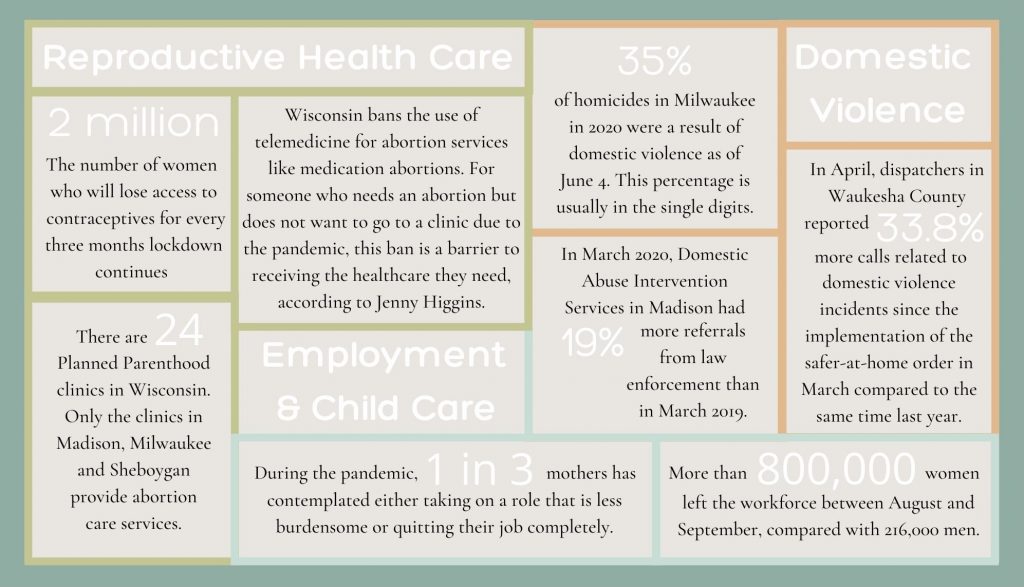How the pandemic is disproportionately affecting women across Wisconsin and the country: A Q&A with three gender & women’s studies professors
Content and design by Paige Haehlke
Access to reproductive health care
Jenny Higgins, professor, gender & women’s studies and obstetrics and gynecology; director of UW CORE, the Collaborative for Reproductive Equity
In what ways has the pandemic affected women’s access to reproductive health care like abortion and contraceptives?
Particularly at the beginning of the pandemic, COVID-19 was having a huge, deleterious impact on people wanting to seek contraceptive and abortion services in Wisconsin. In particular, Wisconsin legislators were arguing that family planning services are nonessential and therefore shouldn’t be happening at all during the early COVID-19 pandemic.
The ability to prevent and terminate pregnancies are quite time-sensitive and quite essential to people who are trying to not have children that they don’t want to have … [It] is especially timely in a moment of grave economic and cultural uncertainty. So, in my mind it’s not just important to provide contraceptive services during this time — it’s more important than ever.
How would an unplanned pregnancy impact a woman’s or family’s life in this time of economic uncertainty?
Those can be incredibly life-changing and consequential for individuals, particularly if they don’t have ready access to termination services or abortion services. The idea of forcing someone to have a child they don’t want to have is always in contradiction to human rights, but is especially in contradiction at a time when folks are already struggling to make ends meet and are facing other kinds of uncertainties in their lives and families.
Domestic violence

Kate Walsh, associate professor, gender & women’s studies and psychology
Why have domestic violence rates risen during the pandemic? Why is it particularly serious during this time?
Along with the stress of COVID-19 and having to quarantine and being in a confined space for long periods of time with others, which increases stress levels, a lot of folks have lost jobs, they’ve lost economic stability — in some cases housing stability — and I think that with stress, we often see rises in violence. With kids being out of school and folks being out of the workplace as well, it’s less likely that others might notice signs that violence is happening and help get them services.
How did stay-at-home orders or the more restrictive quarantine at the beginning of the pandemic affect a victim’s ability to seek help?
At a clinical level we’re seeing that a number of folks are even having a hard time finding spaces within their homes where they can speak to someone on the phone about something private without being overheard. Much of our work has been focused lately on even trying to help people figure out how to shift their ideas around where they’re going to find the space and the time [to talk to someone].
People don’t think the services are available for them any longer. They feel like everything has shut down, including some of these emergency safety services, and so awareness campaigns around the fact that hospitals and shelters and other kinds of things are still open have been really important.
Women’s employment and child care responsibilities
Keisha Lindsay, associate professor, gender & women’s studies and political science
How has the pandemic impacted the traditional gender roles of husband and wife and father and mother?
There’s a lot of people collecting data on this which suggests that the gender roles are hardening again in the sense that the presumption that a woman’s natural place is in the home. There’s a way in which COVID-19 seems to have deepened that. When the decision is made about who has to stay home with the kids, it seems statistically increasingly that, among heterosexual couples, that decision is that it’s the woman who has to stay at home. And some of that might be structural; we live in a society where women earn less than men.
How are women having to balance being a good employee while also being a good mother if they are working and have children home from school?
I think how women are coping is a function of class. I think for middle-class women who have flex hours while online, they’re waking up early, going to bed late. They and their families are forming pods with other families to share child care. And then I think for a lot of working class women, they simply have to leave their kids alone, quite frankly. And so maybe they have the 9-year-old watching the 5-year-old. I don’t think people are broadcasting and publicizing that for obvious reasons, but I think for a lot of women, and for a lot of parents, that is what they’re doing.
